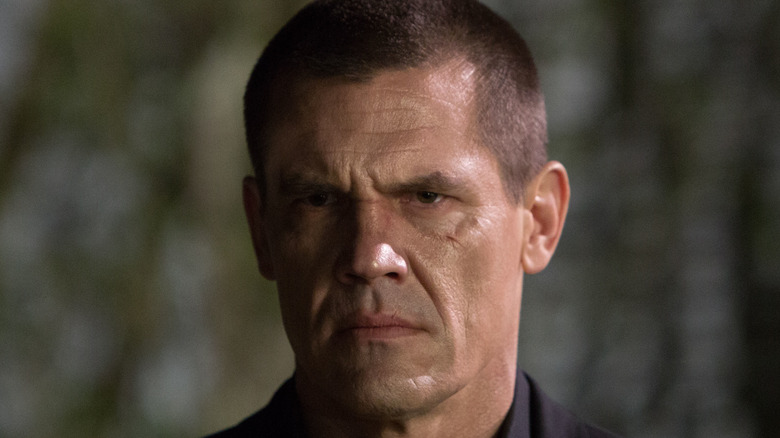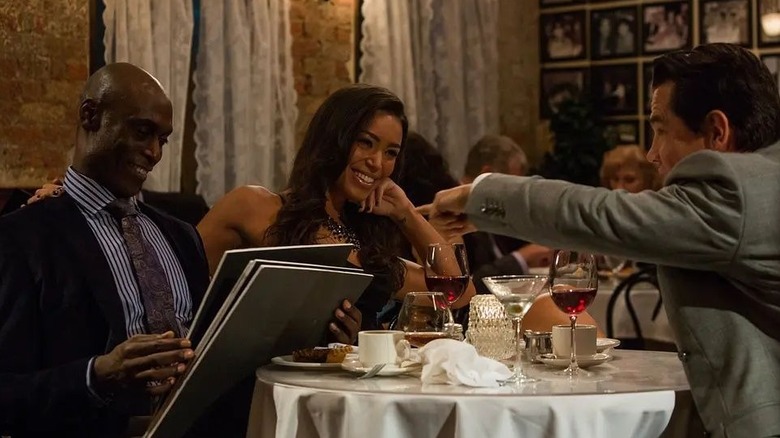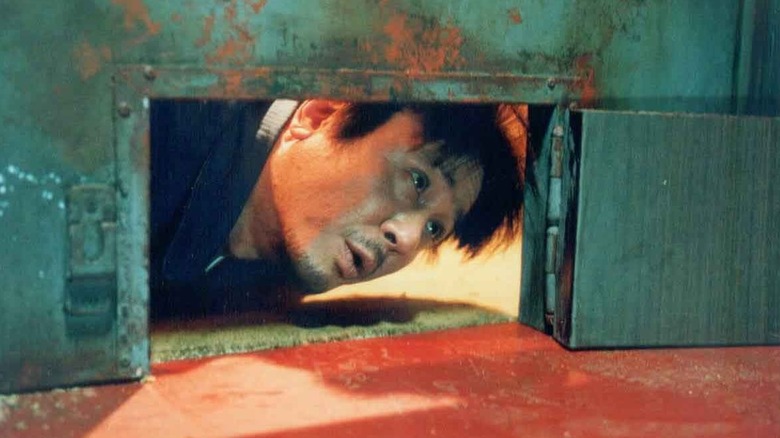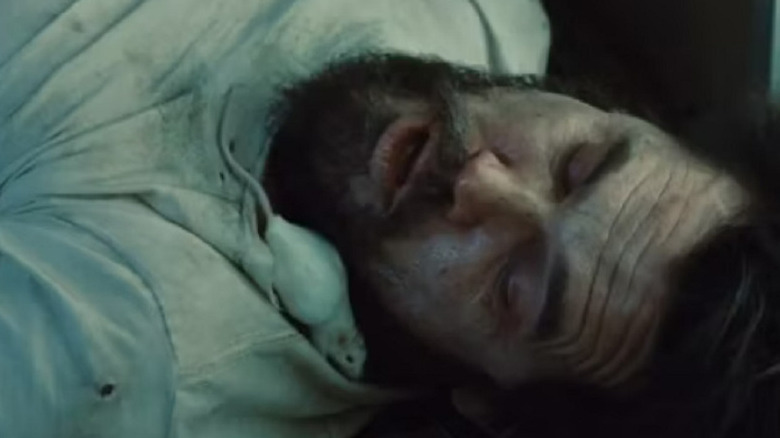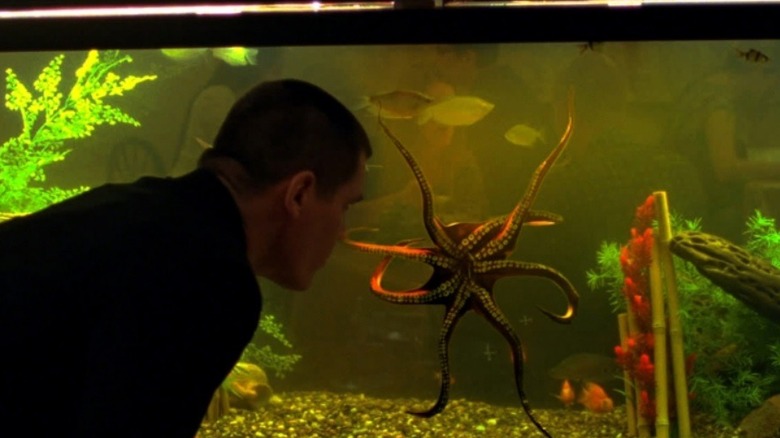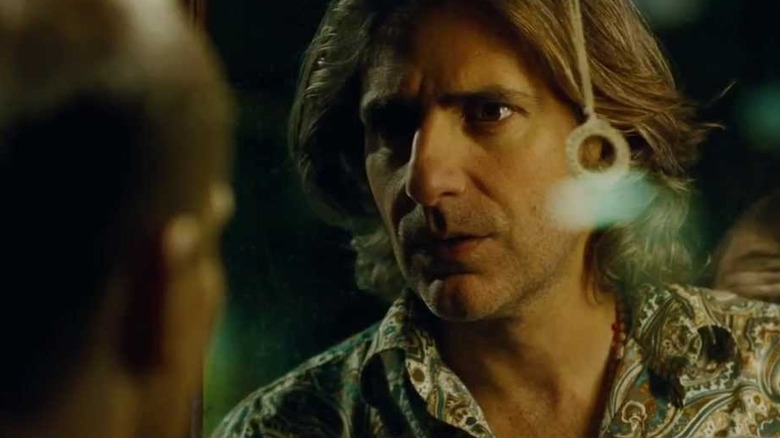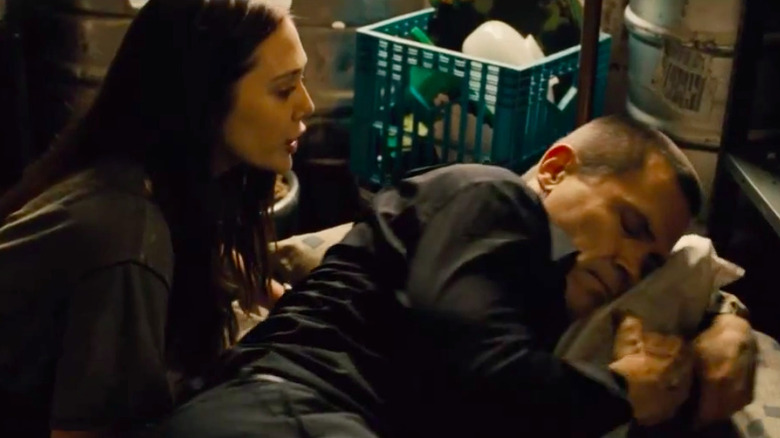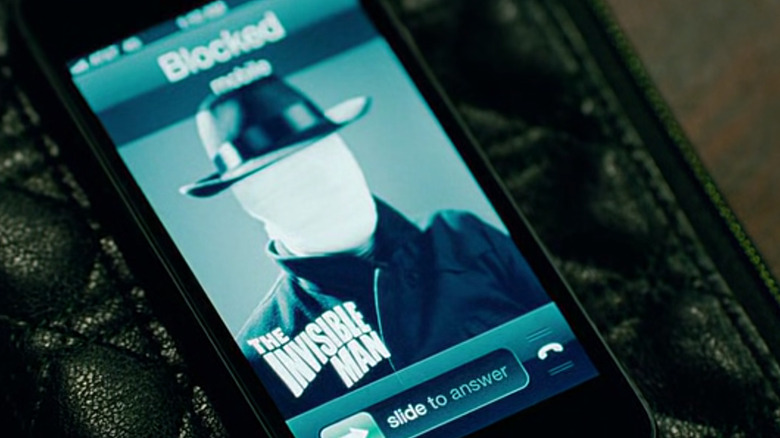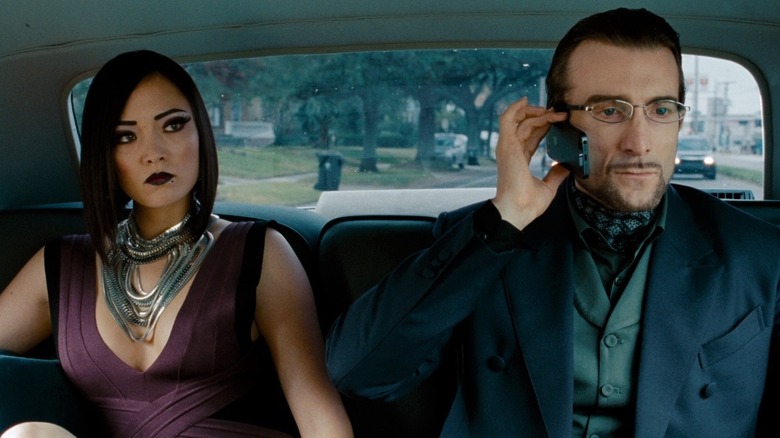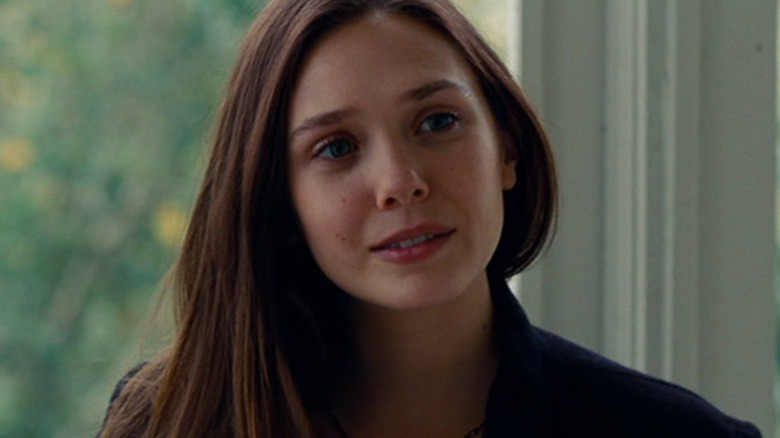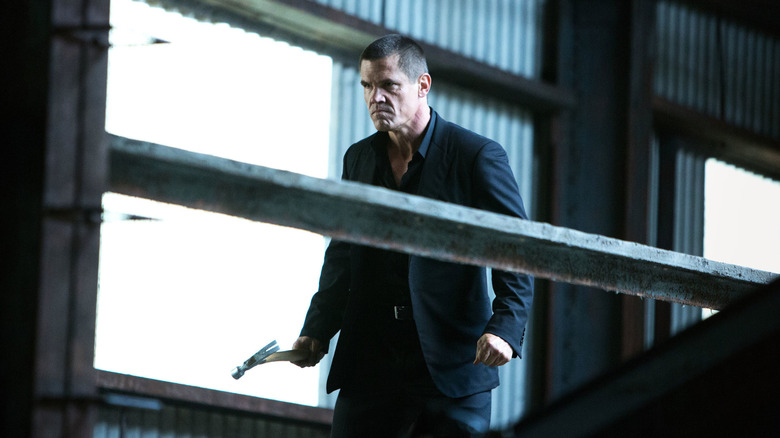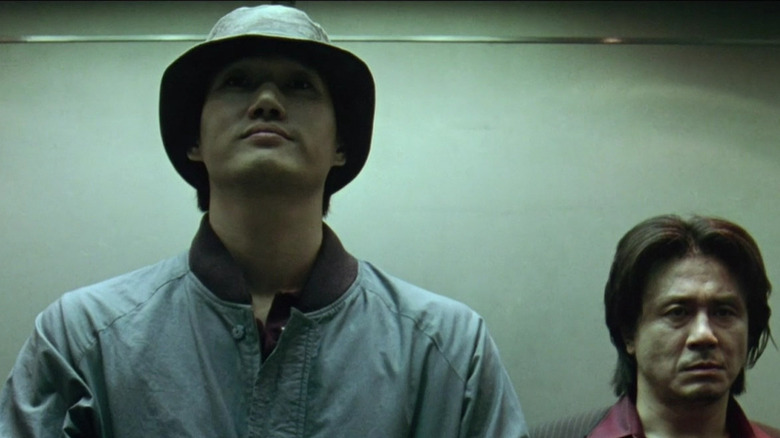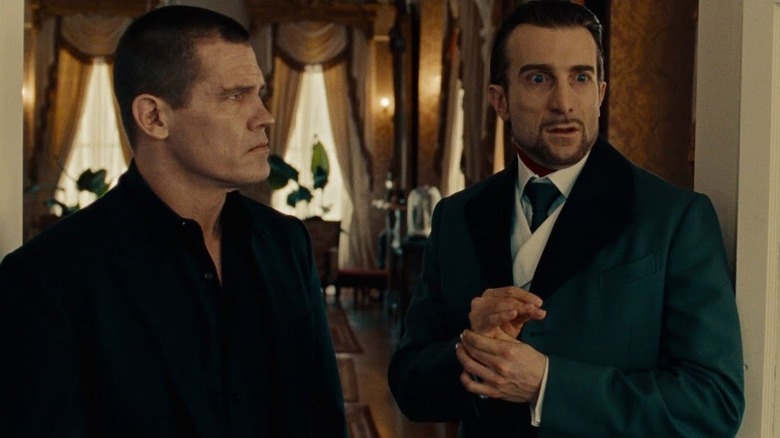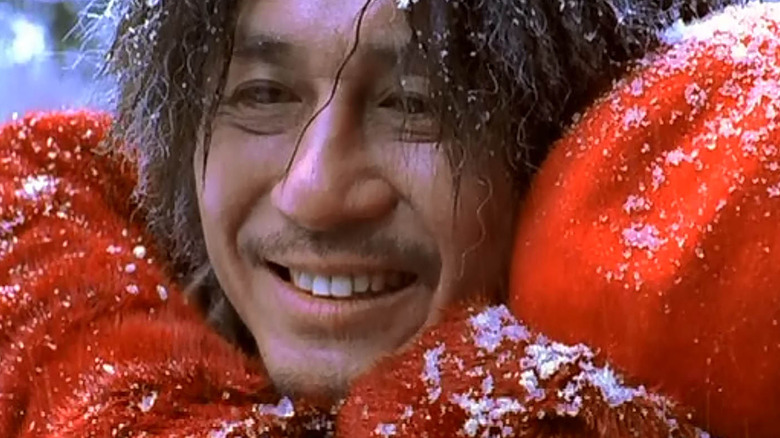The Biggest Differences Between Oldboy And Spike Lee's Remake
When you consider that it was a South Korean film, released in an era before streaming made it easy to watch movies and shows from all over the world, 2003's "Oldboy" ended up finding an impressively large fanbase in the United States.
Much of that probably had to do with strong word of mouth and critical acclaim, but some credit undoubtedly goes to the movie's extreme violence and stomach-churning gut punch of a twist. Nearly two decades before "Squid Game," Park Chan-wook went there with "Oldboy."
The film was also released at a time when the highest compliment Hollywood could give a foreign movie was to remake it with American stars ("Point of No Return," "The Birdcage," "City of Angels," etc). When Spike Lee signed on to direct the American version, it gave people reason to be optimistic, as did a stellar cast that included Josh Brolin, Elizabeth Olsen, Samuel L. Jackson, and Sharlto Copley, among others.
Like most Americanized remakes, 2013's "Oldboy" replicates some key elements of the original, while going in a completely different direction for others. Whether the changes — and the movie itself — are better is a matter of opinion. Below is a (spoiler-heavy) breakdown of such departures, and as with anything "Oldboy," a word of caution: extreme material lies ahead.
The remake spends more time before Joe's imprisonment
One of the reasons to imprison a man but not tell him why — and then keep him imprisoned for many years — is the hope that the man will start to think about all of the enemies he has made and realize there is a long list of people who might want to get revenge on him. Oh Dae-su, the protagonist of the original "Oldboy" film, has no trouble compiling such a list, and he quickly learns that narrowing it down in order to pinpoint who his captor might be is going to be no easy task. But other than that, all the movie does to establish that he might not have been the most upstanding citizen in the world is show him being drunk and belligerent in a police station in a fairly brief sequence at the very beginning of the film.
The remake chooses not to leave things as ambiguous when it comes to Joe Doucett (Josh Brolin), the name of the protagonist in the Spike Lee version. Instead, the movie spends a much longer time with a pre-imprisoned Joe, showing him making crude remarks to a woman at his office and then being rude to the wife of a potential client at a business dinner. While the original mostly just hints at all of this, the remake is sure to explicitly hammer it home.
The length of the prison sentence is increased
What some people don't realize, even if they've seen both versions of "Oldboy," is that it was originally a manga. Even the first movie changes a fair amount from that source material. But one thing that ended up being changed significantly in the story's journey from manga to South Korean film adaptation to American movie remake is the length of time that the protagonist spends in his motel prison.
The manga has the sentence set at ten years. The South Korean film upped it to fifteen, which put Oh Dae-Su's daughter at 18 when he was finally released. Then in the American version, the length of Joe's imprisonment was extended again to a whopping 20 years. This seemingly not only raises the stakes, but ensures that the protagonist's daughter is well into adulthood; she's 23 in the Spike Lee version, 18 in the Park Chan-wook classic.
Given the way things play out between the two of them, making her an adult was a smart move; things are uncomfortable enough as it is, without the added layer of the daughter being just barely of legal age.
The remake introduces a new mouse companion
Throughout Oh Dae-su's 15 year imprisonment in the original "Oldboy," the only direct (conscious) contact he has with any other living, breathing thing is the ankles of the people who slide him his food trays — and, from what we see in the movie, none of them ever speak to him. He remains lonely and isolated the entire time, to the point where he endures hallucinations and imagined connections with people on television.
The remake's Joe is at least given a mouse companion that wanders into the bathroom of his cell one day through a tiny hole in the wall. He immediately bonds with the rodent, setting up a little home and letting the mouse crawl all over him. Unfortunately, his captors end up using this against Joe — one morning, he is unable to find his mouse friend, only to lift the cover off his delivered meal to find that his pet has been served up on a plate. It's a shocking moment, and a cleverly cruel addition.
The live octopus scene from the original is referenced
Among the more infamous scenes in the original "Oldboy" is when Oh Dae-su goes to a restaurant, orders a live octopus, and proceeds to eat it live, as it squirms and struggles in his mouth. Actor Choi Min-sik really did it, and it's a level of commitment to a role that you simply don't see on film very often. Needless to say, Hollywood films have stricter guidelines on what can and cannot be done to living animals — and even if they didn't, few would blame Josh Brolin if he didn't want to eat a live octopus on camera.
Nevertheless, it's a bit disappointing that some equivalent wasn't at least faked in the remake. Oh Dae-su didn't just eat a live animal for shock value — the scene illuminates his character having spent 15 years absent of contact with another living thing, relishing the chance to finally devour something alive, breathing an not served to him on a filthy tray.
The remake does, however, acknowledge the moment; Joe stops to look at an octopus in a tank. An Easter egg for those familiar with the original, it's a nice callback, if not nearly as gutsy.
Joe's college friend is introduced before his imprisonment
Both versions of "Oldboy" have the protagonist reconnect with an old friend from school, who later helps out with the investigation. In the original, the man ran an internet café; given that those were far more of a thing in 2003 than 2013, it makes sense that this was changed to him simply running a timeless ... bar. Most other aspects of the character and his function in the story remain the same, including them both realizing they know who the villain is, and how the protagonist crossed him.
One major difference is in the way the friend is introduced — and more specifically, when he is introduced. In the original, the viewer doesn't meet the friend until Oh Dae-su finds him after his imprisonment. In the remake, Joe tries to go to his friend's bar on the night he is kidnapped — and we see the friend (played by Michael Imperioli) turn Joe away at the door and then come outside later to discover he has disappeared. This creates a nice cyclical moment where Joe once again goes to the friend's bar and frantically knocks on the door to be let in after hours, with the two seeing each other again through the same window where they last glimpsed each other some 20 years prior.
The fake true crime show is new
Not long after Oh Dae-su is kidnapped, his wife is murdered, which leaves their daughter an orphan — and him considered the primary suspect. He discovers this via a news story that (perhaps not coincidentally) comes on the television in his motel room/jail cell. This ends up being the only bit of information he gets as to what happened to his wife and child after his imprisonment, learning nothing more until he is released and begins investigating.
The remake takes things several steps further by having the tragedy be the subject of an episode of a show called "Mysteries of Crime," where the couple who adopted the girl are interviewed, and the girl is shown to be thriving — she has even learned to play the cello. The show revisits the case again later, and Joe sees that episode before his release, depicting his daughter yet again, but now much older.
At the end of the remake, the villain reveals that the entire show was fictional, created only for Joe's benefit. Everyone involved was an actor, including the girl/woman he thought was his daughter. This sets Joe up for the shocking reveal of who is daughter actually is, and how he's already been unknowingly spending a lot of time with her.
The female lead is a nurse instead of a sushi chef
Oh Dae-su meets up with a young woman named Mi-do (Kang Hye-jung) in the original "Oldboy" when he goes to the restaurant, where she works at as a sushi chef. The two engage in some basic banter, and Oh Dae-su recalls that he heard about the woman on television, as she was noted for being such a young chef, among the few women in the profession. Oh Dae-su then mysteriously passes out, waking up to discover Mi-do has taken him to her apartment.
In the remake, Joe meets that movie's version of Mi-do, Marie (Elizabeth Olsen), as he confronts someone in line for the medical truck she is working at as a nurse. Marie ends up treating Joe, who is severely exhausted, malnourished, and dehydrated, and this is how the two of them come to know each other. While the original movie used hypnosis as explanation for why there is a rapid escalation in Mi-do's feelings of sympathy toward Oh Dae-su, the remake's reinvention of her as a nurse creates a credible natural inclination to care for and protect others, particularly someone like Joe who is so clearly in need of help.
Smartphones played a much bigger role in the remake
Looking back on major changes the world would have gone through between the years 2003 and 2013, one has to be the massive adoption of cellphones, fueled largely by such things as the 2007 debut of the iPhone. It makes sense, then, that the "Oldboy" remake would present a smartphone-savvy existence different than its predecessor.
In both movies, the audience is to assume that it is present day when Oh Dae-su/Joe is released from prison. This puts the length of their imprisonment as the number of years preceding the present, cemented by the men watching montages of major news events during their years in the cell. In both cases, a lot about technology has changed while the men were away, which comes into play as they are adjusting to life outside again.
Both men missed the rise of the internet, generally seen as the mid-to-late-'90s, so they both need to have the concept of searching for information online explained to them. But while Oh Dae-su and Mi-do must go to an internet café any time they need to look up information, Joe and Marie have the internet in their pockets, via cell phones. The man who sets up Joe's phone even toys with him, having an image from the film "The Invisible Man" come up whenever he calls. Marie is shown using her phone's Shazam app to find out that the mystery man's ringtone is the fight song from the college Joe attended, a deliberate clue left by the man for Joe to discover.
The antagonist's sidekick becomes an attractive woman in showy outfits
The villain of the original movie was a man named Lee Woo-jin (Yoo Ji-tae); in the remake, it's Adrian Pryce (Sharlto Copley); one key difference between the two is their chosen muscle.
While the original "Oldboy" presented Lee Woo-jin's sidekick/bodyguard as a gruff, mostly unassuming tough guy named Mr. Han (Kim Byeong-ok), the remake goes in the complete opposite direction, its villain flanked by a gorgeous woman who is frequently dressed like a Bond girl.
The woman is named Haeng-bok, and she's played by Pom Klementieff (of the "Guardians of the Galaxy" films) in her American movie debut. Haeng-bok is typically shown in over-the-top outfits that showcase her physical attractiveness, seen in equally elaborate lingerie in the scenes where she and Adrian are alone at home. It is also shown that the two are lovers, and Adrian is visibly distraught when Haeng-bok meets her end at Joe's hands — a far cry from the indifference that Lee Woo-jin shows when Mr. Han dies in the original.
The remake dives deeper on the daughter
While the original "Oldboy" relied on hypnosis to explain a young woman suddenly not only interested in a strange, gruff, middle-aged man but eager to trust, help and even become intimate with him, the remake goes in a very different direction.
The original required a substantial suspension of disbelief on the part of the audience; the remake presents Marie as a more tragic character.
While constructing a fake TV show to make Joe think that his daughter, Mia, has grown up healthy and well-adjusted while being raised by good parents, Adrian Pryce was also busy orchestrating a very different kind of life for Mia/Marie. Adrian specifically found parents that would neglect Marie and cause her to develop various issues with addiction and also with a need to want to help troubled souls in order to make up for what she needed but never got in her own life. In this way, when she encounters a guy like Joe, he's the exact kind of "project" she's eager to take on, leading directly to the two of them becoming close and eventually romantically involved in an accelerated timeframe.
The remake's hallway fight scene takes things to another level
The original "Oldboy" hallway smackdown not only became a classic, it gave birth to an entire sub-category of fight scenes.
If there is any one scene — other than the unsettling finale — that defined the original "Oldboy," this was it. Shot in one long, unbroken take, the scene is viewed entirely from the side angle as it pans back and forth within a crowded hallway; Oh Dae-su takes on dozens of the employees of the hotel he was imprisoned at. It's one of the most impressive action scenes of the last 20 years, and is frequently cited among the best one-shot scenes in movie history.
Spike Lee knew that he owed it to the original to have a similar scene in the remake, so not only did he also do a one-shot hallway fight scene, but he even had Joe climb down to a lower level at one point to give it a little extra flourish. This fight takes it to another level — quite literally.
The camera is a little more free to move around, and there is more space for the performers to stretch out, which some say takes away from the claustrophobic phone booth feel of the first fight. In the theatrical version of the remake, the studio also put in a cut near the end (Lee wasn't a fan) to keep it from being a true one-shot. So, which do you think is better?
The antagonist is more emotional in the remake
Two of the biggest changes between the films, character-wise, come via the main villain and his sidekick. Not only did the sidekick go from male to female, and from basic to elaborate, but the main villain himself is almost unrecognizable. Yoo Ji-tae plays Lee Woo-jin as unsettlingly calm and detached, almost never getting emotional or showing any major shifts in his mood; Copley plays Adrian Pryce as a much more emotive, expressive, over-the-top villain.
Not unlike his sidekick, Copley's Adrian has almost Bond villain vibes, chewing the scenery with every line and spending much of the final act with extremely heightened emotions worn for all to see in his face and body language. Oft-criticized, it is one of the more controversial aspects of the remake, seen by many as one of the worst changes made by Spike Lee.
The remake takes a twist even further
There's no understating how upsetting the "Oldboy" climaxes are, in terms of subject matter. In the original, it is revealed that Lee Woo-jin was having a physical relationship with his own sister, which Oh Dae-su found about and told everyone — the shame of which caused her to take her own life and Lee Woo-Jin to set about his elaborate plot of revenge against Oh Dae-su. Part of that revenge was orchestrating a series of events that would lead him to unknowingly enter into a physical relationship with his own daughter.
Some of that is carried over to the remake, specifically Joe and Marie's relationship and Joe spreading the word about an inappropriate physical encounter he accidentally stumbled upon. Only this time, the encounter was between a young woman and her father, who were revealed to be the sister and father of Adrian Pryce. It was then shown that Adrian also had a physical relationship with his father, though it is never said if the siblings also shared such a relationship with each other. Finally, when it seemed like too much of the outside world had learned of the family's secret, Adrian's father wound up taking the lives of his daughter and wife and attempted to take Adrian's life before finally turning the gun on himself. But Adrian survived his wounds, making it his life's mission to get even with Joe.
If you or anyone you know is having suicidal thoughts, please call the National Suicide Prevention Lifeline by dialing 988 or by calling 1-800-273-TALK (8255).
The ending is significantly different
In terms of story, the biggest — or at least, most significant — difference between "Oldboy" and its remake comes at the very end of the two films.
In the original, Oh Dae-su decides that he wants to protect Mi-do from learning the horrible truth, so he does everything he can not to hurt her. His way of doing this is to have himself hypnotized to forget that she is his daughter, so the two of them can carry on as a romantic couple without Oh Dae-su feeling the guilt and shame of knowing the truth. It is a disturbing moment of self-delusion, one that has surely fueled many post-viewing debates over the years.
In the remake, Joe similarly decides to keep the truth from his daughter — but this time, he doesn't also try to stay in her life and keep them together. Instead, he sends her a letter saying they'll never see each other again, and that she should move on with her life and find a good man who will treat her well. He is then shown checking himself back into his hotel prison, with the implication that he is voluntarily choosing to live there for the rest of his life. It's the less disturbing of the two endings, but similarly has the protagonist making a dark choice: literal imprisonment this time, rather than an imprisonment of his mind.
